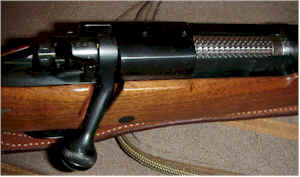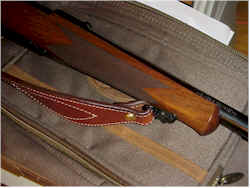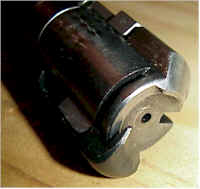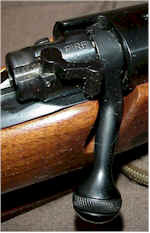Big Guns – You only need one

![]() The .338-378 Weatherby is a great gun, very powerful and very accurate. Both factory and handloaded rounds hold a considerable performance edge over the .338 Winchester and .340 Weatherby. Yes, I did say and mean “considerable”. The Accumark rifle is a perfect example of progressive technological trends: fluted stainless barrel, fiberglass stock, super strong action, aluminum bridgework holding it all together, and a blaster of a muzzle brake. It is so dominant in performance, once I bought the Weatherby, I stopped buying rifles at the upper end of the North American big game power range.
The .338-378 Weatherby is a great gun, very powerful and very accurate. Both factory and handloaded rounds hold a considerable performance edge over the .338 Winchester and .340 Weatherby. Yes, I did say and mean “considerable”. The Accumark rifle is a perfect example of progressive technological trends: fluted stainless barrel, fiberglass stock, super strong action, aluminum bridgework holding it all together, and a blaster of a muzzle brake. It is so dominant in performance, once I bought the Weatherby, I stopped buying rifles at the upper end of the North American big game power range.
I tried the .458’s and .416’s – too slow, ran out of gas too quickly and trajectory looked like slow pitch softball. These calibers are just too specialized in application. The .378 Weatherby, while much more than the .375 H&H, doesn’t offer much more up close than the .338-378, and the minimal gain evaporates at mid and long ranges. The .30-378 doesn’t shoot noticeably flatter and I couldn’t push 300 grain bullets with a .30 caliber. Within the .308 through .375 caliber range, there is no cartridge offering a gain of any consequence over the .338-378 WM.
You may disagree with the close of the last paragraph, you may even shell me from 1,000 yards out with a spiral fluted Ricearoni special or .50 BMG to make a point, but I think the proprietary cartridge manufacturers realize there is no opportunity to advance ballistics in a meaningful way with cartridges based on a full length .416 Rigby or .404 Jeffery case. There are physical limitations in cartridge and gun design that have been reached, and it will be a long time before there is a redesign in any of the related technologies that will be significant enough to move this ballistic barrier. So what you see today, it what you’ll see tomorrow, and it’s no fun looking for a new gun when there’s no anticipation of higher levels of performance. Truly a Prozac moment, and the gun guys aren’t going to help.
Gun manufacturers finding themselves at a ballistics dead end, and needing something to differentiate themselves from one another, are now waving the short powder column theory. The short powder column of a short cartridge offers more consistent ignition, which interprets into greater accuracy from a more compact firearm. So off they went, cutting an inch or two off of the cartridges they only recently introduced, hoping to capitalize on additional accuracy. Okay, but these rifles were already being sold as 1/2 MOA capable. How much more accuracy is needed in a hunting rifle with relatively short range ballistics ? Ballistically, the new cartridges are the equivalent of the .308 Norma Magnum, performance only a .308 Winchester shooter could admire…oops, Sorry.
What a sales pitch – “Get it now, smaller case, less powder, lower velocity and most important, sharply arcing trajectory, and at the same price as the real cartridge” – Hold me back. I’m quite sure at least one firearms manufacturer must have written a strategy statement for the business plan that read – “We’ve worked the market to the point our customers expect $5,000 price tags on rifles and $100 per box prices for 20 rounds of ammo. They see these high prices not as material cost, but the cost of progress. If we start introducing less, but label it as new, we can charge more and put less in the box.” Think I’m kidding ? Then maybe you can explain to me why Lazzeroni charges the same $95 per box for the long case Warbird and 25% shorter case Patriot.
If you’ve been reloading any of the cigar sized rounds, you’ve found you could make premium handloads loads at $15 – $20 per 20 round box, and that’s with all the powder, bullet and primer guys still making a hefty profit. Hmm…I may have just figured out why reps from these manufacturers are always in Tibet hunting the elusive three legged yellow bearded yak, while the rest of us are running around in beat out pickup trucks chasing the elusive 50 lb. white tail, probably with one of those $5,000 rifles.
I started thinking the whole situation over. I wondered what it would be like to have a gun that didn’t kick the crap out of me every time I squeezed a shot off, or required ammo that cost $5 a pop. A nice friendly gun that didn’t have muzzle blast that melted scope optics, or a gun that made enough noise to drive cattle, or caused me to carry around business cards from several leading replacement barrel producers. What if the gun’s finish didn’t double as a signal mirror, or look like a cross section of a rear axle spline from a 3/4 ton Ford truck ? Would be nice if the gun had a stock I didn’t have to pretend to like, one that didn’t look like the inside of a drum from an old Sears’ washing machine.
Digging out of the Xtreme Range Magnum Rut
After several sessions of spousal therapy (I discovered my wife has Dennis Leary’s sense of compassion), we discovered all I really wanted to do within the boundaries of this sport was to shoot a pig. No, not as an act of senseless violence toward our chubby four legged brothers, but rather as a byproduct of an acute need for pork chops and sausage. I saw no other way to get the pig to give them up. In addition, I had hopes that one day my daughter-in-law, a fine young woman and all around wonderful mother and wife, will get beyond her anti gun rhetoric phase and allow me to take my grandson out shooting. I understand he is currently undergoing potty training, so I can probably wait a little longer for what would be an infinitely better circumstance.
My point in all of this and, yes there is a point to all of this, is that there is more to life than 250 grains or so of bullet, over 120 grains of powder, poking holes in paper at a few hundred yards, or taking shots at game so far away the act violates interstate firearms laws. For the sake of the pig, and my grandson, it was time to find a useful gun with maybe a little personality. Some blued steel, some clean straight walnut, chambered for a cartridge I could buy at a general store, or gas station, in towns with a population of less than 1000.
If you read my last article, I ran through the selection process for a light rifle, tossed several models from each major manufacturer, and ended up with a Winchester Model 70 Classic Compact chambered in .243. Not familiar with this model ? Neither was I. In fact, before its arrival, I had never seen one outside of Winchester’s web site and product brochure. As a standard forearm, chambered for a standard cartridge, it would seem that buying one would be a straightforward process. I held onto that thought for the three months it took to to locate the gun, consummate the sale and take possession.
The first two months and two weeks were wasted by an inept dealer. After changing gun stores, it only took two weeks to trans ship the gun twice and get it to the final destination, inclusive of my 10 day CA waiting period. The gun’s route started in Georgia, took a beeline north to New Jersey, hooked a left and ended up in sunny San Jose, CA. I can thank S. Meltzer & Sons, Inc in Garfield New Jersey and my Dad for tracking down the rifle in Georgia, and Reed’s Sports Shop in San Jose, California for making the interstate transfer from New Jersey to CA easy, legal and inexpensive.
Reed’s Sport Shop – 20 minutes and counting
One of the greatest contributions to my enjoyment of the sport, is my wife’s enjoyment of the sport. Pickup day for a new gun in our house is like Christmas. We were up early and at the gun store 20 minutes before the legal pick up time. During the 20 minute wait we selected a set of Uncle Mike’s QD Super Swivels, a Bianchi carry sling and a Dry-Tek SKB soft case. I was tempted to get a narrow shooting sling, and I may still revisit this at a later date. The SKB case comes fitted with excellent hardware and leather reinforcement. The Dry-Tek padding and liner keep moisture away from the gun, and the case has a small external compartment that’s large enough for a box or two of ammo, and some small tools that would be useful in the field or at the range.
Tough to explain our first impression of the gun. We have a lot of rifles from a variety of manufacturers, some very basic and some not basic in anyway. There was just something about this little gun that was very appealing. For one, I honestly think this is the cleanest production gun I’ve taken out of a box in the past 10 years, and it’s appearance confirmed every reason why it was selected above similar gun types from other manufacturers. No little micro scratches or stock imperfections, no dings, dents or missing parts. By comparison, the last new Ruger revolver I picked up looked like it was overdue for 50,000 mile service.
The Winchester Model 70 Classic Compact is billed for use either as a mountain rifle that is lighter in weight than the Model 70 Featherweight, or as a general purpose gun for smaller shooters. Sounds like a marketing guy who is trying to cover a lot of basis and have a reason to have two lightweights in the production line up. With a pull only 3/8″ shorter than a magnum length Super Grade 70, the gun actually isn’t going to solve a short limb problem. It also is not a lot like the picture below, the picture that appears in Winchester literature.

I will apologize in advance for the poor quality of the photo’s that follow. My wife and I are in the process of packing up the house for a move and I’m lucky I’ve been able to find my computer. There is something about a low battery charge and flash output that makes for relatively dark images.
 The gun has a satin finish, which blends in well with the gun’s satin blued metal parts. There are many small finishing touches that really separate this gun from similar models offered by competitors. The jeweled finish on the bolt is tight and consistent in pattern, the bolt handle is knurled and there is a 3 position safety.
The gun has a satin finish, which blends in well with the gun’s satin blued metal parts. There are many small finishing touches that really separate this gun from similar models offered by competitors. The jeweled finish on the bolt is tight and consistent in pattern, the bolt handle is knurled and there is a 3 position safety.
While the gun does not ship with metallic sights,the receiver is of course drilled and tapped for scope mounts.
 Whoever designed this gun knew a lot about proportion, scale and perspective in visual design. The barrel on the compact is stepped down in diameter with a radius, immediately forward of the receiver. The barrel then very gradually tapers to a half inch crowned muzzle with near parallel lines projecting forward from the receiver. The approach gives the gun very pleasing lines.
Whoever designed this gun knew a lot about proportion, scale and perspective in visual design. The barrel on the compact is stepped down in diameter with a radius, immediately forward of the receiver. The barrel then very gradually tapers to a half inch crowned muzzle with near parallel lines projecting forward from the receiver. The approach gives the gun very pleasing lines.
The Remington Model 7 barrel as an example of an alternative design, leaves the receiver at full diameter, skips the radius and continues on into a short, dramatic and awkward taper. It makes the barrel look ridiculously oversized on the receiver end and oddly thin at the muzzle – one of the primary reasons I passed on the Model 7. It looked like Remington was willing to produce a gun with less than desirable appearance to save the cost of one machining step in fitting the barrel.

 The forearm is narrow through the mag well area, the checkering is cleanly cut, and balance at the hand positions give the gun a very substantial feel. I find guns with very light barrels, particularly with wide forearms and low mass forward of the trigger guard, are difficult to hold on target. As an example, the pencil thin barreled Ruger Ultra Light would fall into this category.
The forearm is narrow through the mag well area, the checkering is cleanly cut, and balance at the hand positions give the gun a very substantial feel. I find guns with very light barrels, particularly with wide forearms and low mass forward of the trigger guard, are difficult to hold on target. As an example, the pencil thin barreled Ruger Ultra Light would fall into this category.
By the same token, the Compact’s forearm has a tall cross section so there is plenty of wood to grab onto, more so than the Featherweight model. Even with a relatively short 20″ barrel the gun is remarkably steady to hold on target. The stock inletting is pretty tight, more room around the barrel, tight fit around the receiver, tang, trigger guard and floor plate.
The Compact Classic is a Pre ’64 Design
I won’t go into an explanation of pre ’64 Winchester’s other than to say this date was a line of demarcation between what firearm enthusiasts considered quality Winchester design and materials, and the toll mid 60’s mass production and cost reduction methods took on many products. In reality, worn tooling made even some late pre ’64 production less than exciting. Today’s pre ’64 design guns are probably made with much improved material and control over machining operations. Winchester defines current product with pre ’64 design in several way, dependent upon the product literature selected.
 A very large extractor is designed to pick up the cartridge as it leaves the magazine and is carried into the chamber. The oversized extractor grips almost 1/4 of the case rim when pulling the fired case from the chamber. In other designs, the cartridge floats on the magazine follower and is pushed along by the bolt, and a small extractor grabs the case rim as the bolt is cammed closed.
A very large extractor is designed to pick up the cartridge as it leaves the magazine and is carried into the chamber. The oversized extractor grips almost 1/4 of the case rim when pulling the fired case from the chamber. In other designs, the cartridge floats on the magazine follower and is pushed along by the bolt, and a small extractor grabs the case rim as the bolt is cammed closed.
The Winchester has a fixed blade ejector, so force of ejection is controlled by the force the shooter applies when working the bolt handle during fired case extraction.
 If you can see through all of the new gun grease gunk preservative, there is a three position safety. The safe position physically blocks the firing pin, and the bolt can be removed with the safety on. Blued steel Winchester barrels are hammer forged, just like Weatherby’s and Sako’s.
If you can see through all of the new gun grease gunk preservative, there is a three position safety. The safe position physically blocks the firing pin, and the bolt can be removed with the safety on. Blued steel Winchester barrels are hammer forged, just like Weatherby’s and Sako’s.
An anti-bind slot, supporting and guiding the bolt in operation, is machined into the inside of the receiver. The action is a very tight fitting assembly. This model Winchester has a coned breech, a tapered machined area just in advance of the chamber, designed to guide the loading cartridge without damaging soft bullet tips, damage that could adversely effect accuracy. Nice attention to detail, and consistent with a new gun received with no blemishes on the woodwork and a metal finish free of defects. Even the stamped markings are clean and uniform in depth.
Can it actually hit anything ?
I really like the gun, but I have no idea how well it will shoot, the unresolved part of the firearm equation. This far into it, I have to assume if it won’t shoot straight, I’ll have to stay with it till it does. Then of course there is developing a handload for accuracy, optimized for the short barrel. Lot’s to do. Right now, I need a scope. I’m either going to pick something that is compact and consistent with the useful range of the gun, or I’ll head straight for the overkill. I guess I just need to think about that for awhile…. I’ll get back to you.
More “Looking for a great small gun”
| Looking for a great small gun | |
| Looking for a great small gun II | |
| Winchester Model 70 Scope selection / installation | |
| A gripping story to catch you off guard | |
| Handload Data 243 Winchester |
Thanks,
Joe

Email Notification